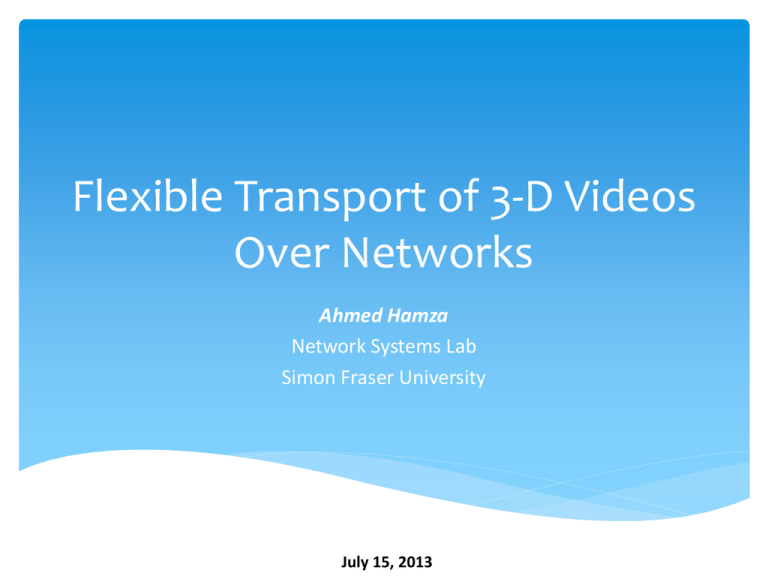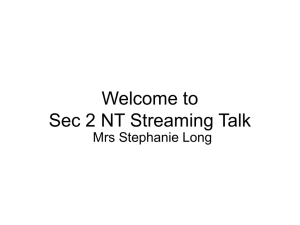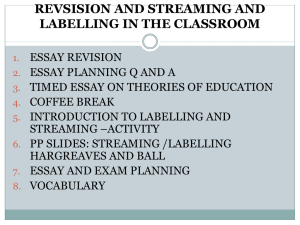slides - network systems lab @ sfu
advertisement

Flexible Transport of 3-D Videos Over Networks Ahmed Hamza Network Systems Lab Simon Fraser University July 15, 2013 Outline Introduction State of the Art 3D Video Representation 3D Video Coding Transport Protocols P2P Streaming Adaptive 3D Video Streaming Stereo Video Multi-view Video Case Study: DIOMEDES Outline Introduction State of the Art 3D Video Representation 3D Video Coding Transport Protocols P2P Streaming Adaptive 3D Video Streaming Stereo Video Multi-view Video Case Study: DIOMEDES Introduction Introduction In the near term, popular 3-D media will most likely be in the form of stereoscopic and multi-view video. Transmission of 3-D media, via broadcast or on-demand, to end users with varying 3-D display terminals (e.g., TV, laptop, and mobile devices) and bandwidths is one of the biggest challenges to bring 3-D media to the home and mobile devices. Two main platforms for 3-D video delivery: digital television (DTV) platforms Internet Protocol (IP) platforms Platform for 3D Media Transport IP-based Delivery Platforms IPTV multimedia services delivered over IP-based managed networks that provide the required level of quality of service (QoS) and experience, security, interactivity, and reliability WebTV services offered over Internet connections that support best effort delivery with no QoS guarantees, making them accessible anytime, anywhere as opposed to IPTV Hybrid DTV-IP Approach The DVB channel is constrained by the physical channel bandwidth to allow transmitting multi-view video (MVV). The IP platform is more flexible in terms of bandwidth but is not reliable. A more recent research direction is to consider a combination of DVB and IP platforms to deliver MVV to provide free-view TV/video experience. Outline Introduction State of the Art 3D Video Representation 3D Video Coding Transport Protocols P2P Streaming Adaptive 3D Video Streaming Stereo Video Multi-view Video Case Study: DIOMEDES Stereoscopic Video The most simple 3D video data representation Each of the two captured views is presented to one of the eyes Can be multiplexed either spatially (passive) or temporally (active) Temporal multiplexing has the advantage of maintaining the full resolution of each view Disadvantage: hardware representation dependency (acquisition process is tailored to a specific type of displays, baseline distance between the two cameras is fixed) Multiplexing Stereo Video Spatial Multiplexing (half the resolution) Time Multiplexing (double the frame rate) Video Plus Depth 2D video signal along with geometry information of the scene texture depth map Multi-view Plus Depth (MVD) Cam-6 Cam-3 Cam-0 3D Image Warping Example Ismaël Daribo and Hideo Saito, “A Novel Inpainting-Based Layered Depth Video for 3DTV,” IEEE Transactions on Broadcasting, vol. 57, no. 2, June 2011 Layered Depth Video (LDV) Main Layer (central color view and depth map) Enhancement Layer (color and depth occlusions) projected on central viewpoint Outline Introduction State of the Art 3D Video Representation 3D Video Coding Transport Protocols P2P Streaming Adaptive 3D Video Streaming Stereo Video Multi-view Video Case Study: DIOMEDES Three-Dimensional Video Coding 3-D video encoding depends on the transport option and raw video format. Simulcast encoding: encode each view and/or depth map independently using a scalable or non-scalable monocular video codec enables streaming each view over separate channels clients can request as many views as their 3-D displays require Dependent encoding: encode views using MVC to decrease the overall bit rate by exploiting the inter-view redundancies a special inter-view prediction structure must be employed to enable view-scalable and view-selective adaptive streaming Multi-view Video Coding (MVC) Multi-view extension of H.264/AVC Enables inter-view prediction Prediction structure is simplified by restricting interview prediction to anchor pictures only Large disparity or different camera calibration affects coding efficiency Reference MVC software (JMVC) temporal and view scalability Multi-view Video Coding (MVC) Multi-view Plus Depth Coding Independently code views and depth maps Dependent encoding is also possible Exploit correlation between texture and depth map Examples: sharing the texture video MVs with the depth map utilizing inter-layer motion prediction tool in SVC Outline Introduction State of the Art 3D Video Representation 3D Video Coding Transport Protocols P2P Streaming Adaptive 3D Video Streaming Stereo Video Multi-view Video Case Study: DIOMEDES Transport Protocols Transmission Control Protocol (TCP) may not be suitable for streaming live video with a strict end-to-end delay constraint lack of control on delay (retransmissions) rapidly changing transmission rate (congestion control) provides good performance when available network bandwidth is about twice the maximum video rate (few seconds pre-roll delay) Transport Protocols Datagram congestion control protocol (DCCP) implements bidirectional unicast connections both data and acknowledgements can flow in both directions congestion-controlled, unreliable datagrams congestion control mechanism selected at connection startup outperforms TCP under congestion when a video streaming scenario is considered Outline Introduction State of the Art 3D Video Representation 3D Video Coding Transport Protocols P2P Streaming Adaptive 3D Video Streaming Stereo Video Multi-view Video Case Study: DIOMEDES P2P Streaming Traditional client-server unicast streaming model is not scalable by nature. Advantage of P2P solutions scalable media distribution (reduce the bandwidth requirement of the server by utilizing the network capacity of the clients/peers) P2P solutions use overlay networks (data are redirected to another peer by the application) Tree-Based Approach Efficient for delivering content from the server that is at the top of the tree to peers that are connected to each other in parent–child fashion. Shortcomings: ungraceful peer exit leads its descendants to starvation replicating the content for feeding multiple trees leads to redundancy within the network Tree-Based Approach Mesh-Based Approach Data are distributed over an unstructured network in which each peer can connect to multiple peers. Increased connectivity alleviates the problem of ungraceful peer exit. building multiple connections dynamically requires a certain amount of time (initiation interval) More suitable for applications that may tolerate some initiation interval. Example: BitTorrent Outline Introduction State of the Art 3D Video Representation 3D Video Coding Transport Protocols P2P Streaming Adaptive 3D Video Streaming Stereo Video Multi-view Video Case Study: DIOMEDES Adaptive Streaming A mechanism should exist to estimate the network conditions so as to adapt the video rate accordingly, in order to optimize the received video quality. Estimation can be performed by requesting receiver buffer occupancy status (to prevent buffer underflow/overflow) combining receiver buffer status with bandwidth estimation Adaptive Streaming DCCP + TCP-friendly rate control (TFRC) TFRC rate calculated by DCCP can be utilized by the sender to estimate the available network rate When the video is streamed over TCP, an average of the transmission rate can be used to determine the available network bandwidth Basic method in DASH Video Rate Adaptation Methods Adapting video rate to available bandwidth depends on the encoding characteristics of the views. One or more views can be encoded multiple times with varying bit rates, sender can switch between these streams according to the network conditions Similar to HTTP live streaming Encoding views once with multiple layers using SVC and switching between these layers Real-time encoding with source rate control Difficult with MVV Adaptive Stereoscopic Video Streaming The behavior of the human visual system is another paradigm for QoE-aware rate adaptation. Exploit the suppression theory human visual system (HVS) tolerates lack of highfrequency components in one of the views One of the views may be presented at a lower quality without degrading the 3-D video perception. Asymmetric quality allocation Just Noticeable Distortion for Asymmetric Stereo Coding Asymmetry can be achieved by scaling the quality in one of the views (secondary view) in spatial, signal-to-noise ratio (SNR) or temporal dimensions Questions Which method should be used? What is the level of asymmetry before observers start noticing visible degradations? Just Noticeable Distortion for Asymmetric Stereo Coding Video Sequence Threshold PSNR (dB) Parallax Barrier Polarized Projector Adile 31.9 33.07 Iceberg 31.64 33.05 Flower Pot 31.19 33.2 Train Tunnel 31.74 32.88 Results show that the “just noticeable” threshold PSNR is 33 dB for the polarized projection display 31.5 dB for the parallax barrier display Asymmetric Encoding for Adaptive Streaming Asymmetric Coding at a Fixed Rate Using MVC Spatial asymmetry using additional down-sampling steps in the encoding process Temporal asymmetry skipping frames skipping from secondary view SNR (quality) asymmetry straightforward compared to other types of asymmetry (encoding quality of a view depends on the quantization parameter used) Asymmetric MVC Coding Alternating views are coded at high and low quality. Inter-view dependencies should be carefully constructed (predict only from high-quality views). Asymmetric MVC Coding Asymmetric MVC Coding Asymmetric Encoding for Adaptive Streaming Scalable Asymmetric Coding Using SVC It is possible to obtain spatial and/or quality scalable right and left views if they are simulcast coded using the SVC standard. Two encoding options for achieving scalable asymmetric stereoscopic video bitstreams when simulcast coding is used: encoding both views using SVC encoding one view with SVC and the other with H.264/AVC Scalable Video Coding (SVC) Asymmetric Encoding for Stereoscopic 3D Video Can be done in two ways: encode both views using SVC base layer of each view is encoded with a quality ~32 dB enhancement layers are encoded at the maximum quality according to channel capacity only one view (the first) is scalably encoded second view is encoded using non-scalable H.264/AVC When the available link capacity is high, the scalable coded view (with the enhancement layer) becomes the high-quality view. Asymmetric Encoding for Stereoscopic 3D Video Outline Introduction State of the Art 3D Video Representation 3D Video Coding Transport Protocols P2P Streaming Adaptive 3D Video Streaming Stereo Video Multi-view Video Case Study: DIOMEDES Adaptive Multi-view Video Streaming Straightforward approach: extend the concept of asymmetric coding to MVV streaming (for relatively small number of views) A more efficient (in terms of bandwidth consumption) and flexible (in terms of number of views) approach: streaming the MVD representation (includes view scalability) View-selective encoding and interactive streaming of multiview video requires computer vision methods for real-time head/gaze tracking, can be used to limit the number of views transmitted View Scaling Discarding one view entirely and falling back to 2D video is not a good choice. switching from 3D to 2D results in significant viewing discomfort With multi-view video (MVV) format, view scaling is a possible option missing view(s) may be outside of the user’s field of view or can be replaced by an artificial view generated at the client side Challenge How to determine which view should be discarded for minimum degradation in perceived quality? QoE-based Adaptation Policy Subjective tests to evaluate the performance of scaling methods in terms of delivered QoE under different network conditions. 5-view 3D display at 1920x1200 screen resolution 12 male and 4 female assessors (7 experts) Description Method # Detail Symmetric Quality Scaling Asymmetric Quality Scaling View Scaling 1 2 3 4 5 6 SNR Spatial SNR Spatial 3c+3d 2c+2d QoE-based Adaptation Policy Recommended adaptation policy: State Method 1 All views transmitted at max quality 2 Asymmetric SNR scaling of intermediate views 3 Keep only edge views (+ depth) and use DIBR Adaptation-ready Encoding Introduce quality difference between adjacent views. View that are either transmitted or not are encoded with H.264/AVC for high coding efficiency. Views that may have different qualities to achieve asymmetry are encoded using SVC. Example: For a five-view display, can perform this efficiently using SVC for views 2 and 4. MVV Adaptation Example a) b) c) High link capacity (4.5 Mbps) Low link capacity (3.3 Mbps) Very Low capacity (2.1 Mbps) Outline Introduction State of the Art 3D Video Representation 3D Video Coding Transport Protocols P2P Streaming Adaptive 3D Video Streaming Stereo Video Multi-view Video Case Study: DIOMEDES Case Study: Project DIOMEDES European project Peer-assisted multi-view video broadcast Scalable architecture that utilizes the upload capacity of peers to assist distribution of up to 200 views and associated 3-D audio Main Idea: DVB-T signal provides stereoscopic 3-D media as a baseline P2P distribution of remaining MVV views over IP to enable immersive free-view TV experience DIOMEDES Architecture Three modules: 3-D content server master peers 3-D media streaming server Peers that use both DVB and IP channels synchronize the received signals. DIOMEDES Client BitTorrent Protocol Adopts a mesh-based topology Flat connections with no hierarchy Adopts a divide-and-conquer approach and splits content into equally sized chunks Peers are of two types: Seeders: have the whole content and upload chunks to other peers Leechers: have some missing chunks BitTorrent Protocol Chunk exchange is managed by two governing policies: Rarest-first chunk scheduling Determines the chunks to be requested Favors chunks that least distributed Tit-for-Tat Determines which chunk requests are to be accepted Sort neighbours based on their level of contribution May deny requests from neighbours at lower ranks Optimistic unchoking Modifications to BitTorrent for 3D Video Streaming Chunk Mapping Variable-size layered chunks All chunks are self-decodable Each chunk contains multiple GoPs Adaptive video streaming in 3D video streaming, rate adaptation is not straightforward and may depend on external information such as the user’s field of view, the encoding scheme, and the display properties Modifications to BitTorrent for 3D Video Streaming P2P engine determines when to perform adaptation (discard/add a stream). Adaptation module determines which streams should be affected first. Modifications to BitTorrent for 3D Video Streaming Chunk Downloading ready-to-play buffer buffer duration is a variable that provides feedback on the overall content retrieval rate Modifications to BitTorrent for 3D Video Streaming Chunk uploading Request prioritization Favor requests that belong to streams of high priority Depth map streams should have the highest priority because they are used to generate multiple views at the client side. Base and enhancement layers may be prioritized similar to the case of 2D video streaming Other Use Cases Full-resolution stereoscopic 3D video delivery Full resolution source video is encoded as an enhancement layer to the base stream in a framecompatible format that is transmitted over the DTV channel. The enhancement layer is transmitted to enable full resolution 3D video for users with Internet access Other Use Cases Other Use Cases Head tracking system for multi-view video delivery head tracking system coupled with a stereoscopic display View pairs change according to a user’s viewing position if the available link capacity is low, only required video streams are received, based on the feedback from the head tracking device increase efficiency of rapid view selection by using a sparse camera arrangement and transmitting corresponding depth maps Conclusions Digital TV platforms are not flexible to support multi-view video (cannot provide sufficient bandwidth). Three adaptive streaming solutions: Asymmetric streaming Streaming using MVD Selective streaming Combining adaptation methods with adaptive P2P video streaming will provide a successful 3D video services solution in the near future. Streaming holographic 3D video over IP might be possible on the long term. References Flexible Transport of 3-D Video Over Networks, Proceedings of the IEEE, 2011 Peer-to-peer system design for adaptive 3D video streaming, IEEE Communications Magazine, 2013 DIOMEDES: Content Aware and Adaptive Delivery of 3D Media over P2P/IP and DVB-T2, Networked & Electronic Media (NEM) Summit, 2011 Evaluation of Asymmetric Stereo Video Coding and Rate Scaling for Adaptive 3D Video Streaming, IEEE Transactions on Broadcasting, 2011 Thank You!




